Daily schedule
Daily schedule 18/07/2025
| All | Building no. | Time |
|---|---|---|
| Swiss Culture Stage | 711 | 10.15 - 16.30 |
| Guided walking tour | 731 | 13.30 - 14.30 |
| Hands-on activity | Building no. | Time |
|---|---|---|
| Woodland playground | 311 | 10.00 - 17.00 |
| All yours – create Ballenberg anew | 531 | 10.15 - 16.30 |
| Bring on the water! | 491 | 10.15 - 16.30 |
| Children`s games | 622 | 10.15 - 16.30 |
| Covering a tiled roof | 141 | 10.15 - 16.30 |
| Enchanted Forest | 711 | 10.15 - 16.30 |
| Hands-on cheese tradition | 352 | 10.15 - 16.30 |
| Hands-on house | 221 | 10.15 - 16.30 |
| Planing and woodwork | 1021 | 10.15 - 16.30 |
| Plucking and carding wool | 751 | 10.15 - 16.30 |
| The magic of silk | 851 | 10.15 - 16.30 |
| Coffee in the parlour | 1361 | 11.30 - 16.30 |
| Experience Alpine traditions up close | 1361 | 11.30 - 16.30 |
| Crafts demonstration | Building no. | Time |
|---|---|---|
| Baking bread | 333 | 10.15 - 12.00 |
| Bobbinlace making | 111 | 10.15 - 16.30 |
| Cooking | 531 | 10.15 - 14.00 |
| Filet crocheting | 611 | 10.15 - 16.30 |
| Pottery | 1051 | 10.15 - 16.30 |
| Smoking | 321 | 10.15 - 16.00 |
| Spinning | 1111 | 10.15 - 16.30 |
| Weaving | 851 | 10.15 - 16.30 |
| Making cheese | 1361 | 11.00 - 12.30 |
| Sawing | 691 | 13.15 - 15.45 |
Our programme today
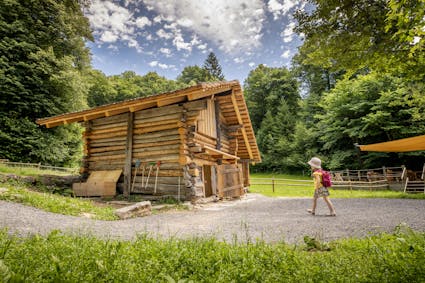
Woodland playground
From listening to testing your balance, from building sandcastles to hide-and-seek – the playground at the ‘Alter Bären’ Restaurant (311) on the edge of the forest is a fun place for children of all ages.
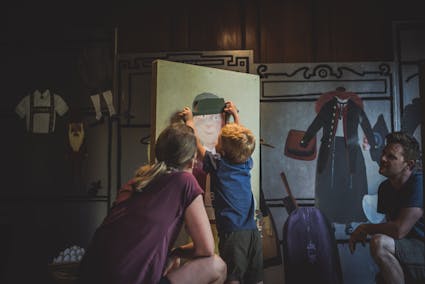
All yours – create Ballenberg anew
Younger visitors can have a go at rearranging the Swiss Open-Air Museum – thanks to the magnetic pieces!
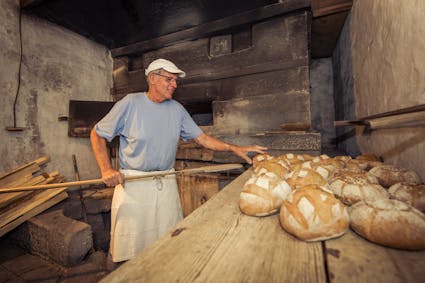
Baking bread
In olden days baking your own bread was of great importance in order to put food on the table. Farmers’ wives would bake their bread in the oven houses, which were often owned by the local community. In the baking room of the Stöckli from Detligen/Radelfingen BE (333) the Museum’s bakers fire up the wood-burning oven every day in the early morning.
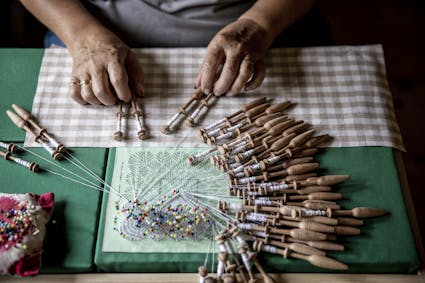
Bobbinlace making
Bobbin lace-making is like weaving but with threads which are wound around spools of a type called bobbins. The threads are crossed over each other.
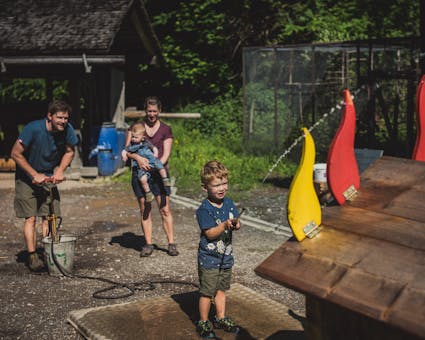
Bring on the water!
There’s a fire! At the ‘Brandboden’ our younger guests can pretend they’re in the fire brigade! When the bucket is filled with water, the hand sprayer is used. Using all their strength they have to pump enough water to put out the fire. When the bell rings, you’ve beaten the fire.
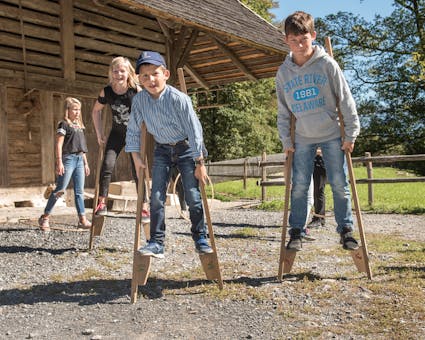
Children`s games
In the cellar underneath the granary (622), our younger visitors can play with the toys of their ancestors. Little ones can walk around on stilts, ride a hobbyhorse, look through children’s books, pile up building blocks, dress up rag dolls or play a game of ring-toss – now, how many of those old games do you remember?
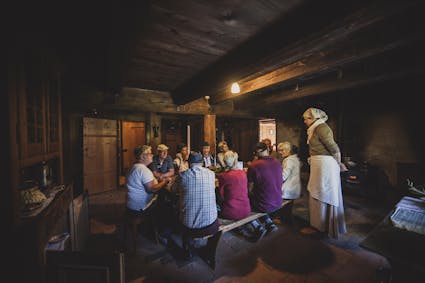
Cooking
In the hut farmhouse from Villars-Bramard, Vaud (531) people cook as the farmer's wives used to do every day. Come by and try a bite.
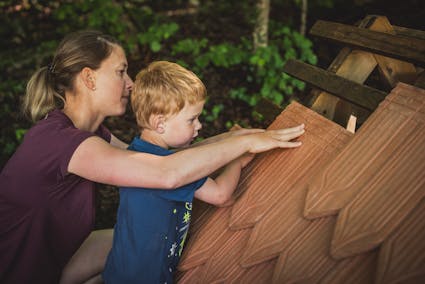
Covering a tiled roof
The individual roof tiles are heavy, but they keep out the rain for many years. Have a go yourself and help re-roof our houses. Use the spray can to test whether your roof is watertight.

Enchanted Forest
An elf and his helpers meet at the edge of the woods. They are the principle figures in the exhibition "Enchanted Forest" and lead the children from one theme to another.

Filet crocheting
Certain parts of the festive costumes such as the headscarf or the gloves are filet crocheted or knotted, and filet crocheting is based on the same knot-tying techniques as those used for making a fishing net.

Hands-on cheese tradition
There’s a lot to do in the cheese storehouse. Let’s do our bit. Take a seat on the milking stool and try your hand at milking, or move the cheese wheel to a new storage spot. Our little guests can carry the cheese on their backs using the traditional wooden frame. Try on clothes as they were worn 100 years ago.
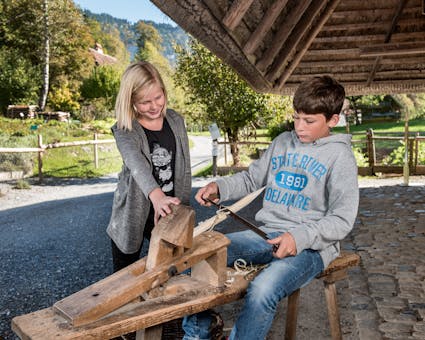
Hands-on house
You can touch the exhibits here – and join in fun, hands-on activities too. Depending on the day, experts will help you learn how to weave straw, do woodwork or even print bags.
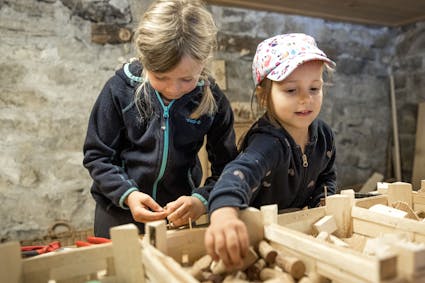
Planing and woodwork
The hobby workshop in the Dwelling from Matten BE (1021), invites you to do it yourself.
The hand plane is used to finish wood surfaces, joints and edges. You can try out this tool at the workbench and take the pieces home with you. On the second table, found, leftover and collected materials for recycling are available for crafting. You can find ideas in the sketchbook on site, where you can also record your project for other visitors.
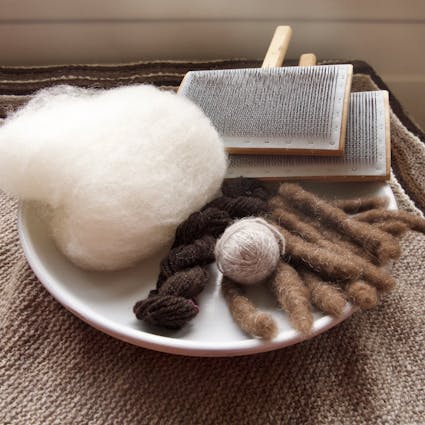
Plucking and carding wool
Watch how wool is plucked and carded in the dwelling from Schwyz SZ (751).
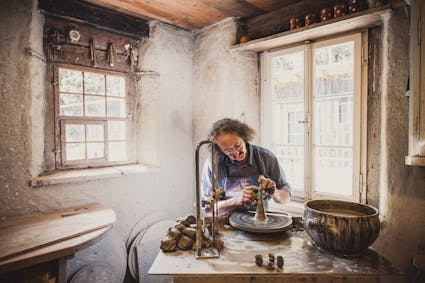
Pottery
In the Small Farmhouse from Unterseen BE (1051) there is a small pottery workshop, just like the ones found in villages in the old days, when pottery was made by hand in small family enterprises. All the various stages of production are to be seen at Ballenberg, from the turning on the wheel, to the pre-firing (bisque firing), to the glaze firing, to the engobe decoration. The potteryware can be purchased directly in the pottery workshop.
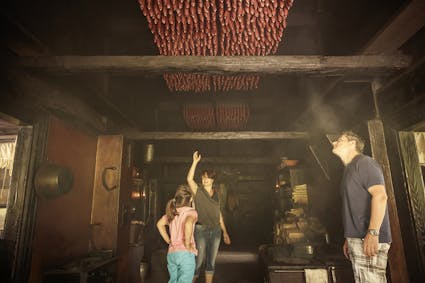
Smoking
In the dark kitchen of the farmhouse from Madiswil BE (321) farmers’ wives prepared the daily food. They stood in the smoke for many hours at the low stove - an everyday life that is hard to imagine. The smoke from the hearth fire served to preserve sausages, bacon and other pieces of meat. These days sausages hang from the ceiling in smoke - you can purchase these ‘homemade’ sausages in the Ballenberg shop.
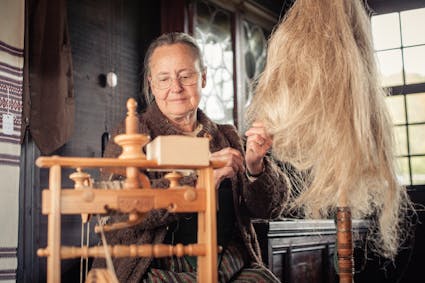
Spinning
Flax and wool are regularly spun into thread in the dwelling from Blatten, Valais (1111) and the farmhouse from Wila, Zurich (641). Patience and skilled hands are needed to spin plant fibres or animal hair. Spinning is a painstaking task. However, sometimes people would come together for a chinwag while spinning.

Swiss Culture Stage
Experience the diversity and vibrancy of Swiss folk culture on the Swiss Culture Stage at the Swiss Open-Air Museum. From 5 July to 17 August 2025, Ballenberg’s historical backdrops will be transformed into a stage for Swiss folk culture. The programme includes yodelling, alphorns, brass bands, choirs, folk dancing and accordion music from all over the country.
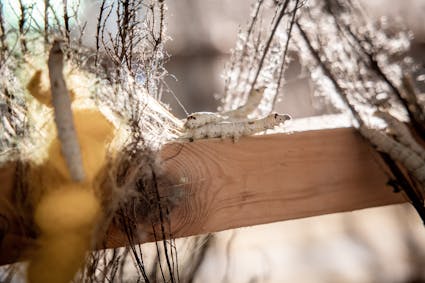
The magic of silk
How does the silk worm moth spin its precious silk cocoon? Find out how the extremely thin silk thread, which is up to 3 kilometres long, forms a cocoon.
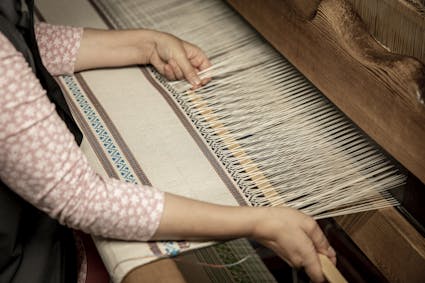
Weaving
The women weavers in the Ballenberg Open-Air Museum regularly sit at the 200-year-old loom in the weaving cellar, letting the shuttles glide across the warp. In the weaving cellar it is possible to purchase handwoven products such as the legendary “Znüni”, bread bags with the Haslital pattern, or towels and linen Kirschstein bags.
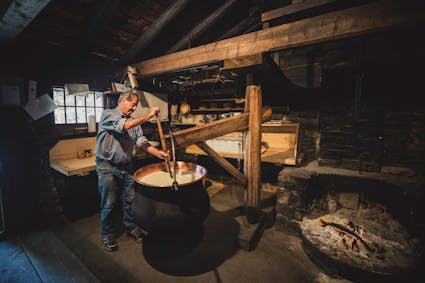
Making cheese
The cheese dairy in Ballenberg functions on an almost daily basis. In House (1361), the Alpine Cheese Dairy from Kandersteg BE, visitors can not only look at the various bits of apparatus needed for cheesemaking but also follow the process itself as it happens.
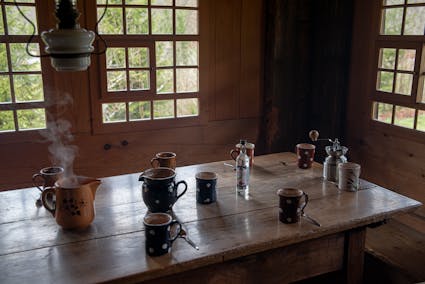
Coffee in the parlour
The table in the old living room and bedroom is a spot for lively and sociable exchanges. Take a seat – there’s coffee and tea ready for you.
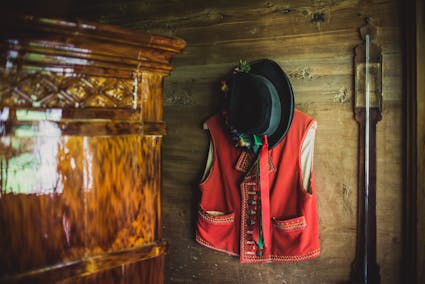
Experience Alpine traditions up close
Here, you can get a hands-on insight into our rich Alpine culture. Visitors are free to touch and try out everything in this room, from strapping on a milking stool to milking a cow. Our younger visitors can dress up in the kinds of clothes people used to wear 100 years ago, or try carrying cheese around on their backs.
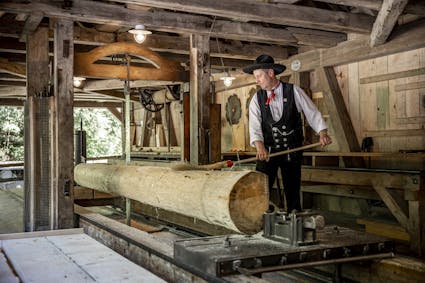
Sawing
The loud puffing and wheezing in the Sawmill from Rafz ZH (691) can be heard from a long way off. The regular rhythmic noise of the machine is an almost daily feature at the Ballenberg Open-Air Museum when the sawyers start it up and begin sawing wood the old way. The drive mechanism is a showpiece in itself. The power is delivered by an overshot water wheel. The water shoots out of the channel from above, falls on to the wheel blades and sets the wheel in motion. The drive power is transmitted to the frame saw in several stages by means of giant cog wheels and transmission belts.

Guided walking tour
Ballenberg has many stories to tell. Our guides will take you on a walking tour through the museum. Meeting point at 1.30 pm next to the Restaurant Degen (731). The tour is in german.
Gastronomy
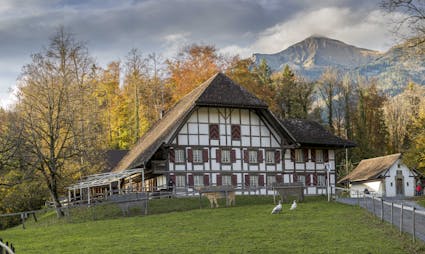
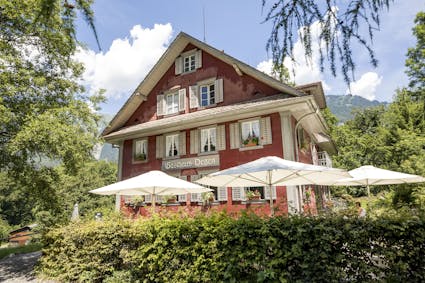
In our daily schedule we constantly publish the activities for the season. The plan is updated monthly, so please check back from time to time.
Ballenberg
Swiss Open-Air Museum
Museumsstrasse 100
CH-3858 Hofstetten bei Brienz
Opening hours
10 April to 2 November 2025
10 am to 5 pm daily